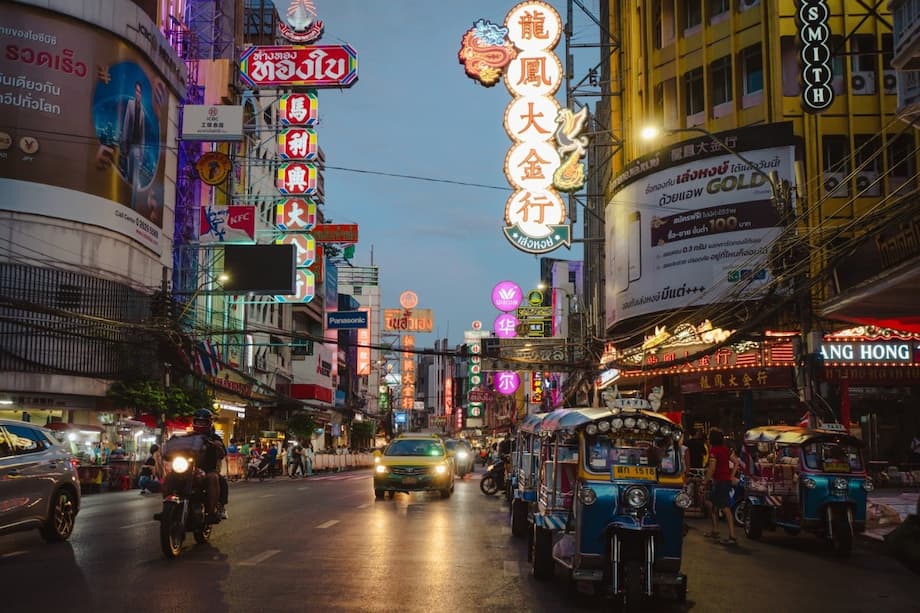A city of contrasts that rewards wandering
Bangkok reveals itself best at street level. Start amid the vaulted arches of Hua Lamphong railway station, drift by foot into the neon maze of Chinatown, then follow the Chao Phraya river north to a creative pocket called Song Wat. Cross the water to Thonburi for canals, temples, and markets that feel unchanged by time. Between these stops you will taste noodles scalded in smoking woks, hear live bands in tucked away bars, and see a skyline that glitters far into the night.
- A city of contrasts that rewards wandering
- From Hua Lamphong to Yaowarat by feel, not by app
- Song Wat, where heritage meets a new creative wave
- Across the river to Thonburi for canals, curry, and calm
- Where to eat like a local and what to order
- Live music, bars, and late night energy
- Rivers, parks, and the city’s green lung
- Getting around without losing hours to traffic
- Where to stay, from riverside classics to modern hubs
- When to visit, what to pack, and how to keep costs sensible
- Should you hire a local guide
- Planning your first days like a local
- What to Know
Locals often describe the Thai capital as two cities in one. There is the high rise universe of shopping centers and rooftop lounges, then a more intimate city of shrines, shophouses, ferries, and alleyway kitchens. The trick is to slow down and let the contrasts sit side by side. That is where Bangkok becomes most rewarding, both for your taste buds and your sense of discovery.
Bangkok based designer Saran Yen Panya suggests a low tech way to find the heart of the place. Before we get to his advice, picture the route: an early morning train whistle at Hua Lamphong, light cutting through incense smoke in a Chinatown shrine, a bowl of peppery soup at a tiny stall, then vinyl bins and art in an old warehouse by the river. It is a walk that sums up the city’s yin and yang.
Saran Yen Panya, a Bangkok designer, puts it simply: “Just head from the station towards the Chao Phraya river. Do not use Google Maps.”
From Hua Lamphong to Yaowarat by feel, not by app
Hua Lamphong, opened in 1916 with a design lineage that nods to Italian influence, still sends trains out on the Eastern Line and shelters a small museum. Step outside, turn toward the river, and within minutes you enter Chinatown. Yaowarat Road, the main artery, is a permanent traffic jam of chrome and neon. The best eating is rarely on the big road. You find it in the narrow lanes that thread past Chinese shrines, dragon trimmed roofs, and stacked crates of herbs and teas.
Look for small stalls with a weathered metal cart, a few plastic stools, and a cook working with total focus. These mom and pop places often specialize in one thing perfected over decades. Oyster omelettes with crisp edges, braised pork leg with star anise gravy, duck noodle soups, or Tom Yum with a balance of lime and chili that lingers long after the bowl is empty.
Before we turned down a side alley, Saran offered a cheeky rule of thumb that many Bangkok eaters swear by.
“Always look for the grumpiest looking auntie cooking,” he joked. “The worse the service, the better the food.”
Tips for this walk
Arrive early evening when Chinatown wakes, then continue to the river as the air cools. Wear breathable clothing and carry small cash for stalls. If you get turned around, ask for Yaowarat, Talat Noi, or Song Wat and follow local directions rather than a screen. The journey is the point here.
Song Wat, where heritage meets a new creative wave
The riverside strip of Song Wat has the air of a working district in transition. Warehouses and trader shophouses share space with artisan cafes, vinyl sellers, micro galleries, and vintage clothing stalls. Weekends see small markets pop up in converted spaces like Long Dang Dang, where second hand records and retro fashion draw a mixed crowd of locals and curious travelers. A community initiative called Made in Song Wat has helped small businesses preserve heritage and inject fresh ideas into the neighborhood.
Near the gate of the 19th century Luang Kocha Itsahak Mosque, a private gallery called TARS Unlimited now shows contemporary figurative work after moving from Sukhumvit. It is a sign of the area’s pull for young creatives. When you visit, dress modestly near places of worship and move slowly. Many shopkeepers are long time residents. A smile and a few words of thanks go a long way.
Across the river to Thonburi for canals, curry, and calm
Thonburi, a former capital until the 18th century, sits on the west bank of the Chao Phraya. It feels more residential, stitched together by quiet canals and small markets. Wat Arun, the Temple of Dawn, rises here in riverside white, but the real pleasure is wandering back streets and tasting food cooked by families from Thai Chinese and southern Thai backgrounds. Prices tend to be lower than in central tourist corridors.
Two casual spots show the range. Tong Leng serves home made egg noodles in light broth with crisply roasted pork and fishballs. Jae Oie plates Thai Chinese stir fried noodles that carry the unique green snap of kra ched, the water mimosa found in the region. Both are plain looking, both are loved by regulars. If you are after a wider sweep of classic dishes, Talat Phlu market sits next to the Bangkok Yai canal and is known for long running stalls and sweets. The BTS Skytrain makes it simple to reach.
Savapatra Euakittaropakorn, a singer who grew up in Thonburi and plays in garage bands, describes the difference between riverbanks in a way that resonates with many residents.
“I grew up in Thonburi, on the other side of the river. It is just somehow more real there,” she said.
How to explore Thonburi smoothly
Take the Skytrain to Talat Phlu or Wongwian Yai, then a short taxi or motorcycle ride to the canals. Longtail boat tours through the khlongs are popular. Pick a licensed operator, agree on the fare before boarding, and ask the driver to stop at a neighborhood temple or market rather than only tourist photo spots.
Where to eat like a local and what to order
Bangkok is a paradise for street food and no fuss shophouse restaurants. Eating well rarely requires reservations or large budgets. Chinatown, Wang Lang Market near Siriraj Hospital, Silom Soi 20, and Nang Leong Market are reliable areas where stalls get busy as the sun goes down. If heat and humidity make street dining tough, head inside to shopping center food courts. Many of the best mall food courts recruit skilled cooks and subsidize stall rent, which keeps prices low and quality high while you enjoy air conditioning.
Street food hotspots to try
In Yaowarat, hunt for oyster omelette specialists, braised pork over rice, and peppery fishball noodles. Around Victory Monument, look for boat noodles, small bowls of rich broth and sliced beef or pork, served in sets. Wang Lang has grilled pork skewers, sticky rice, and herb drinks seemingly on every corner.
What to order when choices overwhelm
Use this short list as a compass. Most dishes come in small portions and sharing is normal, so order a few and keep going until you are satisfied.
- Tom yum goong, spicy sour shrimp soup with lemongrass and lime
- Som tam, green papaya salad pounded to order
- Pad ka prao, basil stir fry served over rice with a fried egg
- Boat noodles, intense broth served in small bowls
- Hoi tod, crispy oyster omelette
- Guay jub, rolled rice noodle soup with five spice broth and crispy pork
- Pla pao, whole fish grilled in a salt crust with herbs
- Mango sticky rice, the classic dessert to finish
If you want an affordable taste of headline makers, look for places like Jeh O Chula for giant noodle bowls after dark or plan ahead for a counter seat at famous wok masters. Some of these spots draw long lines; arriving right before opening helps.
Live music, bars, and late night energy
The city’s nightlife extends well beyond rooftop cocktails. A new wave of live music bars keeps things intimate and eclectic. Tep Bar in Chinatown pairs inventive cocktails with traditional Thai instruments. Studio Lam brings molam and global grooves to a small room loved by the indie crowd. Brick Bar, tucked off Khao San Road, is a high energy hangout where house bands play ska and Thai indie covers for big groups. Black Cabin leans into contemporary jazz, soul, and indie rock in an industrial space. JAM, part art room and part venue, hosts everything from punk to experimental sets.
Up in Ari, a residential neighborhood north of the old city, a temporary bar called Doi Dum Punk has become a draw for musicians and night owls. It sits on the corner of Ari Soi 5, a short ride from the old city. If you love vinyl and curated listening rooms, Siwilai Sound Club near Central: The Original Store programs live sessions on a top shelf system. Dress is casual, and most bars accept walk ins, but small venues fill quickly on weekends.
Rooftops worth the elevator ride
Bangkok’s skyline never loses its lustre. The Mahanakhon Skywalk gives a glass floor view of towers and sois below. Octave on Sukhumvit offers 360 degree views at sunset. Riverside terraces at classic hotels are timeless, where a drink at the bar can be as memorable as dinner. If you prefer something different, take a river boat at golden hour and watch the city trade neon for gold light.
Rivers, parks, and the city’s green lung
The Chao Phraya river is a practical transport route and a scenic escape. The orange flag express boat is an inexpensive way to hop between piers near Chinatown, the Old Town, and Thonburi. For fresh air, cross to Bang Krachao, often called the city’s green lung. Rent a bicycle and ride shaded pathways between homes and gardens, stopping for coconut ice cream and a temple visit. Back in town, Benjakitti Forest Park has a raised walkway over wetlands that glows at dusk. Families will find plenty to do around these green corners.
Getting around without losing hours to traffic
Bangkok’s road grid is tangled by small lanes that often dead end into bigger roads. That is why the BTS Skytrain and MRT underground are the default choice for residents who can use them. Both are clean, air conditioned, and reliable, covering most central areas at low cost. River ferries add a breezy option between key neighborhoods. For short hops, motorcycle taxis are fast but best for confident riders. Grab cars and regular taxis work well for door to door trips, but meter use is essential. If a driver refuses to turn on the meter, find another car. Plan temple visits early in the day to beat both heat and congestion.
Where to stay, from riverside classics to modern hubs
Bangkok’s hotels are part of the experience. On the river, long standing grande dames offer calm and craft that feel miles from the street rush, despite being minutes away by ferry. Newer riverside properties bring spa level luxury and floor to ceiling views. In the city core, a color splashed tower at Mahanakhon has become a favorite for design fans, while a newly refreshed icon near Lumpini Park blends Thai heritage with contemporary rooms. Neighborhoods matter. Siam puts you steps from mega malls and the art and culture center. Silom and Sathon balance business towers, leafy lanes, and markets. Sukhumvit stretches for miles with dining from every corner of the globe. Chinatown and the Old City place you near temples, ferries, and late night food.
When to visit, what to pack, and how to keep costs sensible
November through February brings the most comfortable weather with lower humidity and cooler nights. That is also high season, so book early. Songkran, the Thai new year water festival in April, and Loy Krathong, the river lantern festival in November, are unforgettable, but both mean bigger crowds. Pack light, breathable clothing, a hat, and modest outfits that cover shoulders and knees for temple visits. Refill a water bottle and take breaks inside malls or at riverside piers to cool down.
Costs are friendly to most budgets. Street meals often run less than the price of a coffee in many Western cities. Public transport fares are modest, and ferries are cheap. Currency exchange booths like well known chains near transit hubs often have good rates. Common sense safety goes far: watch for pickpockets in packed areas, keep valuables zipped up, and beware of classic scams near temples such as a stranger saying a site is closed and redirecting you to a shop. If you want a massage, traditional schools attached to temples, such as the one at Wat Pho, are respected choices.
Should you hire a local guide
Bangkok is very doable on your own with trains, ferries, and a flexible plan. A private guide can be a smart option if you have limited time, want help navigating menus and markets, or prefer a deeper dive into history and culture. Licensed guides tailor the day to your pace, line up transport, and time visits to beat queues. They also smooth language gaps and introduce family run spots you might pass without noticing. If you go this route, confirm licensing, agree on costs up front, and outline your must sees to avoid a rush.
Mandy, a licensed private guide who leads small custom tours, describes the value of having a companion for the city’s intensity in a way many short stay visitors will understand.
“Bangkok is a city of vibrant street life, ancient temples, hidden canals, and unforgettable flavors. But without the right guide, it is easy to miss the heart of it all,” she said.
Planning your first days like a local
A good starter plan blends must see landmarks with food and neighborhoods. Day one, take the river to the Grand Palace and Wat Phra Kaew in the morning, cross to Wat Arun, then eat by the river and finish with Chinatown snacks. Day two, ride the Skytrain to Siam for art and shopping, then head to Song Wat for coffee, records, and gallery browsing before drinks at a riverside terrace. Day three, explore Thonburi’s canals and Talat Phlu, then catch a live band in the evening. Leave a half day for Bang Krachao or a massage and a slow meal. Keep plans flexible, because in Bangkok the best moments often come from a turn you did not plan to take.
What to Know
- Start at Hua Lamphong, then walk to Chinatown and the river to feel Bangkok’s street rhythm
- Yaowarat’s best eats are in back lanes, not the main road
- Song Wat mixes heritage shophouses with new galleries, cafes, and vinyl stalls
- Thonburi offers canals, lower prices, and classic dishes around Talat Phlu
- Use BTS and MRT first, then boats and taxis; avoid gridlock when possible
- Street food hubs include Yaowarat, Wang Lang Market, Silom Soi 20, and Nang Leong
- Mall food courts are affordable, cool, and packed with quality stalls
- Live music thrives at small venues like Tep Bar, Studio Lam, Brick Bar, and Black Cabin
- Rooftop views shine at Mahanakhon and Octave; ferries give sunset scenery for less
- Best weather runs November to February; festivals include Songkran (April) and Loy Krathong (November)
- Dress modestly for temples, carry small cash, and watch for common taxi and temple scams
- Private guides can save time and unlock hidden food and culture when schedules are tight




